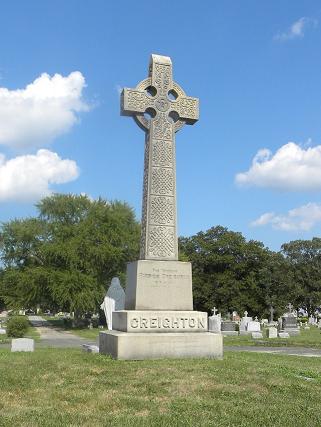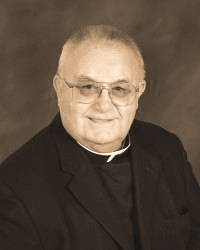 |
 |
AN HISTORICAL SKETCH
(Based upon text by Cross, Samuel B., Immaculate Conception: From the Beginning 1970.
Images, articles, and large amounts of information added by John Kneski)
In 1869 St. John the Evangelist was founded in Riverhead; the first resident pastor was Rev. John A. Casella. He had served at St. Peter's Church in Brooklyn from 1868 to 1869, and at St. Patrick's in Brooklyn before that. He erected the church in Riverhead, and laid out a cemetery. The story of the Parish of The Immaculate Conception begins in the same year, with the establishment of a mission by Father Casella to serve the area, including Westhampton, Quogue and Catchaponack (now Westhampton Beach). In the order to appreciate the pastoral challenges of this period, one must visualize Father Patrick Creighton, arriving by horseback from Riverhead a few years later, to celebrate the first Mass in Quiogue at the home of Francis and Margaret Eagar Foley, beside Aspatuck Creek near what is now Franklin Avenue (the house was later moved to No. 20 on the north side about 500 feet west of Ocame Avenue). It was Mr. Foley's personal request that Father Casella designate the area as a Mission of his Parish.

Father Casella in a Brooklyn Daily Eagle article from 1870
Father Creighton's sporadic visits to the Foley household continued until 1885 during which period the Foleys conveyed to Most Reverend John Laughlin, Bishop of the Diocese of Brooklyn two parcels at "a place called Quiogue" fronting on Main Road (laid out in 1868 by Jabez Foster and William N. Ocame) and measuring 5700 square feet including the site of the present rectory on which the first Church was built. In 1891 the Foleys gave additional adjoining land so that the Church property now measured 100 by 125 feet whereupon the second Church was built on the site of the present Church. The original building then became a store and the home of Stephen Foley, was later moved to the north side of Meeting House Lane about 700 feet east of the Presbyterian Church and, still later, moved to its present location on the north side of Foster Lane where, remodeled and enlarged, it is a private residence.
 .
.
Father Patrick Creighton (1817-1904)
First Priest to the Immaculate Conception Mission of Quiogue.
(Right: His monument in St. John's Cemetery, Riverhead, NY)
- obituary here -
With the erection of the new and larger Church, the Mission was designated as Immaculate Conception Parish; and for the ensuing twenty years priests came here from elsewhere to celebrate Sunday Mass. In 1913 Father John Patterson became the first resident Pastor; and on June 1, 1914, "The Roman Catholic Church of The Immaculate Conception at Quiogue in the County of Suffolk, State of New York erected in the Diocese of Brooklyn" was incorporated under the Religious Corporation’s Law by Right Reverend Charles E. McDonell, Bishop of the Diocese of Brooklyn, Monsignor George Kaupert, Vicar General of the Diocese Father Patterson, and Walter Kubak and Patrick Kenny as laymen Trustees of the Church.

Sag-Harbor Express article mentioning Father Patterson from 1916
Appointment of a resident Pastor had become necessary with the increasing influx of summer parishioners together with, around the turn of the century, a gradual migration to the area of people of Central European and Polish origin. Appropriately, therefore, Father Patterson was succeeded as pastor in 1918 by Father Joseph Slomski (1891-1963) age 27 and only recently ordained.
Father Joseph Slomski (1891-1963) at the shrine in front of the church.
Photo courtesy Mr. & Mrs. Paul Kneski (click to enlarge)
Since the pastorate of "Father Joe" as he was affectionately known in the neighborhood spanned four decades, an outline of the priest and his work is basic to this account. Only a few years after arriving in Quiogue and, undaunted by his tiny congregation, Father Slomski drew plans for the present Church and in March 1922 petitioned Bishop Thomas Molloy to approve construction "of a Church to be built by stucco and to have a seating capacity of five hundred people." Bishop Molloy finding that the Parish was in need of, and could support a much larger church than the 1891 edifice, approved the plans and work began immediately with August 1st as the target completion date. When dedicated by Bishop Molloy in November, 1922, the Church was regarded by some parishioners as "ridiculously large." Nevertheless, within the next decade, the 1891 Church, which has been moved to its present location on Franklin Avenue and now serves as a Parish Hall, was needed in the summer months to accommodate overflow Sunday congregations. The year 1922 also witnessed the enlargement and renovation of the rectory built by Father Patterson in 1914. Father Joe's impact upon the community was substantial, including service as chaplain to the Suffolk County Air Base, Westhampton Beach Fire Department, Southampton Lodge of Elks and State Troopers in eastern Suffolk County. Blessed with a prodigious memory and gregarious disposition, he reached out to the entire community, segments of which, for some thirty years, tendered him an annual dinner, usually at Canoe Place Inn. In 1954, Father Slomski, apparently with the intention of establishing a parochial elementary school, acquired the triangular parcel bounded by Meeting House Road, Ocame Avenue and Main Road; and in the same year, in order to facilitate parking for Sunday Masses, acquired a site at the northeast intersection of Main Road and Alden Lane. For the same purpose a site at the northwest corner of Ocame and Franklin Avenues was later acquired from Walter W. Thorne, Norman Hubbard and Walter Fritchie, as Fire Commissioners of the Quiogue Fire District.

Father Joseph F.X. Canning
In July 1958, Father Slomski relinquished active pastoral duties and Father Joseph F.X. Canning, then teaching at St. Pius X Seminary in Uniondale, was appointed Administrator of the Parish, serving with the assistance of Father Francis McCormack until July 1963, when he was succeeded by Very Reverend James J. Griffin. Within a few years, Monsignor Griffin faced the choice of (a) building an elementary school or (b) finding a different use for the above-described site. A 1967 poll of the parishioners showed that building an elementary school was disfavored by a wide majority. Accordingly, Monsignor Griffin, after consulting the Parish Trustees and the Holy Name Society, decided in favor of a Confraternity of Christian Doctrine program and a campaign was launched to finance construction of a School of Religion primarily to serve released-time instruction needs of the parish children and to contain classrooms and an assembly-hall for use as a gymnasium and auditorium, all to cost an estimated $450,000. When opened in September 1968 to the Parish's nearly 500 Confraternity of Christian Doctrine students, the school was acclaimed as the first diocesan Confraternity of Christian Doctrine School. In the successful funding drive, Monsignor Griffin was strongly supported by Father Diarmuid McGann and many parishioners organized by Messrs. Phillip Alpert and Robert Stevens. The formal dedication by Bishop Walter Kellenberg occurred on May 17,1969 during the brief pastorate of Father James J. Casey, with Father Canning preaching the dedication sermon. The school has proved indispensable not only for the originally designed purpose but also for the overflow summer Masses and as a substitute Church during the two periods when the main Church was closed for renovation.
In October 1969 Father Theodore LeTure became Administrator and later Pastor serving with the assistance of Father George Rozycki until September 1976 when he was installed as Pastor of Valley Stream, Long Island. During Father LeTure's pastorate, the altar and sanctuary were rearranged to facilitate the liturgy prescribed by Vatican II.
 |
 |
Reverend Theodore J. LeTure |
Reverend George Rozycki |
Father LeTure had been named Pastor in Westhampton Beach in 1976 after having served there since 1969 as its Administrator. A Valley Stream resident, Father LeTure was born on March 15, 1925 and studied at St. Agnes School, Rockville Centre and Central High School in Valley Stream. He then attended Mount St. Mary's College and Seminary in Emmitsburg, Maryland. He was ordained on June 11, 1949.

Father Murray in May of 1985
In October 1976 Father Canning returned to become our sixth Pastor, relinquishing his pastorate at St. Patrick's Smithtown; and, following his retirement in December 1981, Father Joseph Murray, Irish-born, veteran of the African Missions and after serving in several parishes of the Diocese of Rockville Centre, was appointed Pastor. In the ten years of his pastorate, our parish has continued to grow and prosper, and people are welcomed, encouraged to participate and drawn to share in the liturgical, spiritual and educational life of the parish. During that period and under Father Murray's leadership, the Church and grounds have been beautifully restored and landscaped, and the completion thereof, coinciding with the sixty-fifth anniversary of the Church was fittingly observed on June 14, 1987 with Bishop McGann presiding at the Re-Dedication Mass followed by a reception in the School of Religion. Thus, we come to celebrate this 100th anniversary of our beloved Parish of the Immaculate Conception in a setting that is spiritually alive and physically beautiful. This joyful occasion is also a time for giving thanks for the enduring faith and dedication of the many priests and parishioners who have labored and sacrificed at Immaculate Conception since it all began here one hundred years ago.
While accounts differ as to the date of designation as a Parish, see Long Island Catholic, and Rogers, under Sources, fixing the 1891 date, although others say that the designation year was 1893, or even later coinciding with the appointment of the first resident pastor, the old maps attest that the "R.C. Church of the Immaculate Conception" has been on Quiogue since 1891.
SOURCES
Cross, Samuel B., Immaculate Conception: From the Beginning (1970).
Hampton Chronicle: March 1922 and 1957 Anniversary Issue.
Long Island Catholic: July 30, 1964 and various issues. 1967 -1969.
Rogers, Beatrice G., History of the Incorporated Village of Westhampton Beach, New York, 110 (1953).
Sharp, Right Reverend Monsignor John K., History of the Brooklyn Diocese, Volume 1, 128, 171 (1954); Priests and Parishes of the Diocese of Brooklyn: 1820 to 1944, 233 (1944).
Suffolk County Land Records.
Westhampton Beach Village Archives, Edward H. Rogers, Jr., Historian.
This website is maintained by Prof. John Kneski, Miami, Florida
Please direct all inquiries and/or submissions for the website to this email: kneskij@bellsouth.net
